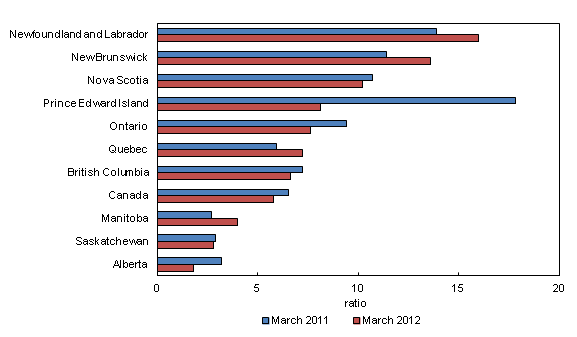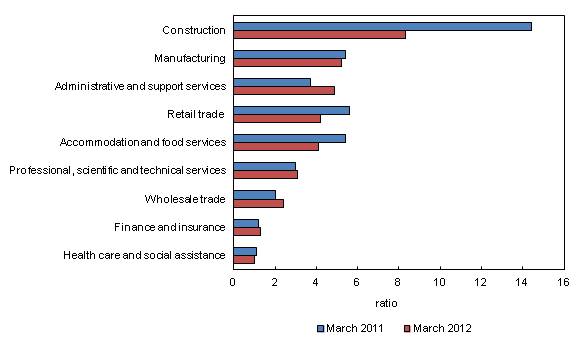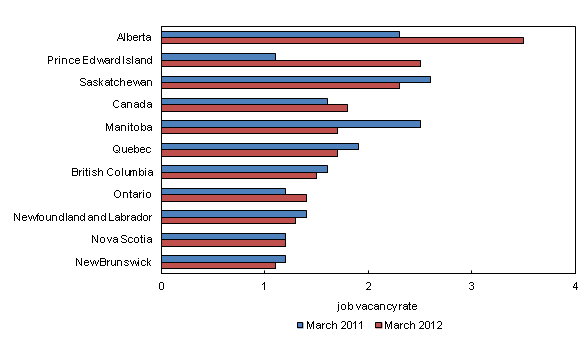Job vacancies, three-month average ending in March 2012 (preliminary data) (correction)
Archived Content
Information identified as archived is provided for reference, research or recordkeeping purposes. It is not subject to the Government of Canada Web Standards and has not been altered or updated since it was archived. Please "contact us" to request a format other than those available.
Related subjects
-
[an error occurred while processing this directive]
There was an average of 248,000 job vacancies in the three-month period ending in March, an increase of 19,000 from the same period in 2011. For every job vacancy, there were 5.8 unemployed people, down from 6.5 in March 2011.
The decline in this ratio of unemployment to job vacancies was a result of both the increase in job vacancies and a decline in the number of unemployed people.
Ratio highest in the East, lowest in Alberta
Provincially, the highest ratios of unemployed people to job vacancies were in Eastern Canada. In Newfoundland and Labrador, there were 16.0 unemployed people for every job vacancy in March, followed by New Brunswick (13.6) and Nova Scotia (10.2). These ratios were little changed from 12 months earlier.
Unemployment-to-job vacancies ratio, all unemployed people, by province, three-month average, March 2011 and March 2012

In March, the ratio was 7.6 for Ontario and 7.2 for Quebec, both little changed from 12 months earlier.
In Manitoba, the ratio rose from 2.7 to 4.0 over the same period, entirely because of a decline in job vacancies from 13,000 to 9,000.
The lowest ratio was in Alberta, where there were 1.8 unemployed people for every job vacancy, down from 3.2 in March 2011. The decline was a result of both a drop in the number of unemployed people and an increase in job vacancies.
In Prince Edward Island, the ratio fell over this 12-month period from 17.8 unemployed people per job vacancy to 8.1. This decrease was a result of an increase in job vacancies from 600 to 1,300, while the number of unemployed people was unchanged (see 'Data quality' in the Note to readers).
Ratio by sector
Sectoral analysis of the ratio of unemployed people to job vacancies is limited to individuals who last worked within the past 12 months, as unemployment data by sector are only available for this group.
Among the largest industrial sectors, construction had the biggest decline in the unemployment-to-job vacancies ratio. There were 8.3 unemployed people for every vacant job in construction in the three-month period ending in March, down from 14.4 in the same period a year earlier. The drop was the result of both a decline in the number of unemployed people and an increase in job vacancies.
Unemployment-to-job vacancies ratio, by largest industrial sector, unemployed people who last worked within past 12 months, three-month average, March 2011 and March 2012

In manufacturing, the ratio was 5.2, little changed from 12 months earlier.
In retail trade, the ratio was 4.2 in the three-month period ending in March, while in accommodation and food services, it was 4.1. The ratios declined in both sectors compared with 12 months earlier. In retail trade, the number of job vacancies and the number of unemployed people both increased. In accommodation and food services, job vacancies rose, while the number of unemployed people declined.
In March, health care and social assistance had a ratio of 1.0, little changed from 12 months earlier. However, the number of job vacancies and the number of unemployed people both declined in this sector.
In mining, quarrying and oil and gas extraction, there were 1.7 unemployed people per job vacancy, one of the lowest ratios of all sectors. This was down from 3.1 in March 2011, a result of an increase in job vacancies.
Job vacancy rates
The job vacancy rate is the number of vacant positions divided by total labour demand, that is, vacant positions plus occupied positions. It corresponds to the share of jobs that are unfilled out of all jobs available. Higher job vacancy rates are often associated with periods of economic growth, while lower rates may be associated with periods of slower growth or economic contraction.
The national job vacancy rate was 1.8% for the three-month period ending in March, up slightly from 1.6% a year earlier.
Job vacancy rate, by province, three-month average, March 2011 and March 2012

Chart description: Job vacancy rate, by province, three-month average, March 2011 and March 2012
Provincially, the highest job vacancy rate was in Alberta, at 3.5%, up from 2.3% in March 2011. In Prince Edward Island, the rate more than doubled from 1.1% to 2.5%.
In Manitoba, the job vacancy rate fell to 1.7% from 2.5% a year earlier, the largest decline among the provinces.
Newfoundland and Labrador, Nova Scotia and New Brunswick had the lowest rates. All were little changed from 12 months earlier.
Job vacancy rates by sector
Among the largest industrial sectors, construction had the highest job vacancy rate, at 2.3% in March, up from 1.5% a year earlier. The sector had 18,000 vacancies in the three-month period ending in March.
The next highest job vacancy rate was in administrative and support services, at 2.1%, down from 2.8% a year earlier. The sector had 16,000 vacancies in March.
The lowest job vacancy rate among the largest sectors was in manufacturing, at 1.4%, little changed from a year earlier. There were 21,000 vacancies in this sector.
Among all sectors, mining, quarrying and oil and gas extraction had the highest job vacancy rate, at 3.5%, twice the average for all sectors combined. This rate was up from 2.2% in March 2011. The sector had nearly 8,000 vacancies, up from 5,000 a year earlier.
Annual 2011
For 2011 as a whole, there were 235,000 job vacancies on average. There were 5.9 unemployed people for every job vacancy, and the job vacancy rate was 1.7%.
Provincially, the highest unemployment-to-job vacancies ratio in 2011 was in Prince Edward Island, at 13.2, followed by Newfoundland and Labrador, at 12.2. The lowest ratios were in Saskatchewan (2.6) and Alberta (2.7).
Among the largest industrial sectors, the unemployment-to-job vacancies ratio was highest for construction (9.2) and lowest for health care and social assistance (1.2).
The highest job vacancy rate among these sectors in 2011 was 2.6% for administration and support services, while the lowest was 0.7% for educational services.
Note to readers
Data on job vacancies are collected through the monthly Business Payrolls Survey (BPS). Starting with the January 2011 reference month, two questions were added to the BPS, which is the survey portion of the Survey of Employment, Payrolls and Hours. These questions were: Did you have any vacant positions on the last business day of the month, and how many?
The target population is the same as that of the BPS and comprises all employers in Canada, except those primarily involved in agriculture; fishing and trapping; private household services; religious organizations; the military personnel of the defense services; and federal, provincial and territorial public administration.
With this release, data have been revised for all months in 2011 as well as January and February 2012.
Funding for the development and initial collection of data on job vacancies came from Human Resources and Skills Development Canada.
Data quality
Job vacancy and unemployment estimates are based on samples, and are therefore subject to sampling variability. Estimates for geographic areas and industries with smaller numbers of vacancies or smaller unemployed populations are subject to greater sampling variability.
Data on job vacancies are not seasonally adjusted and should only be compared on a year-over-year basis. Given this is a new data series, trends are not yet available and therefore, data should be interpreted with caution.
All data are based on three-month moving averages. For example, data for March are based on an average of the data from January, February and March.
Definitions
Job vacancy / vacant position: A position is considered "vacant" if it meets all three of the following conditions: a specific position exists, work could start within 30 days, and the employer is actively seeking employees from outside the organization to fill the position.
Labour demand: Total labour demand is the sum of met (total payroll employment) and unmet (vacant positions) labour demand.
Largest industrial sectors: The sectors with the largest levels of payroll employment for which we have publishable job vacancy data.
Job vacancy rate: The number of vacant positions divided by total labour demand, that is, vacant positions plus occupied positions
Unemployment-to-job vacancies ratios
All unemployed people: The unemployment-to-job vacancies ratio for all unemployed people is calculated by dividing the total number of unemployed people, regardless of their previous work experience, using Labour Force Survey (LFS) data, by the number of vacant positions. This ratio reflects how many unemployed individuals are available for each vacant position and is a measure of the overall labour market tightness.
By sector: For each sector, the ratio is calculated by dividing the number of unemployed people who last worked in that sector in the previous 12 months, using LFS data, by the number of vacant positions in the same sector. This excludes new entrants to the labour market as well as unemployed people who had not worked during the previous 12 months. Unemployment data by sector is known only for those who worked within the previous 12 months.
Use of data for the last sector worked does not imply that these unemployed individuals continued to look for work in that sector. This ratio reflects how many unemployed individuals who last worked in that sector are available for each vacant position in the sector. It is a measure of the labour market tightness within that sector.
Definitions, data sources and methods: survey number survey number2612.
Preliminary data on job vacancies for April will be released on July 18.
For more information or to obtain data, contact Statistics Canada's National Contact Centre (toll-free 1-800-263-1136; 613-951-8116; infostats@statcan.gc.ca).
To enquire about the concepts, methods or data quality of this release, contact Jason Gilmore (613-951-7118), Labour Statistics Division.
- Date modified:
